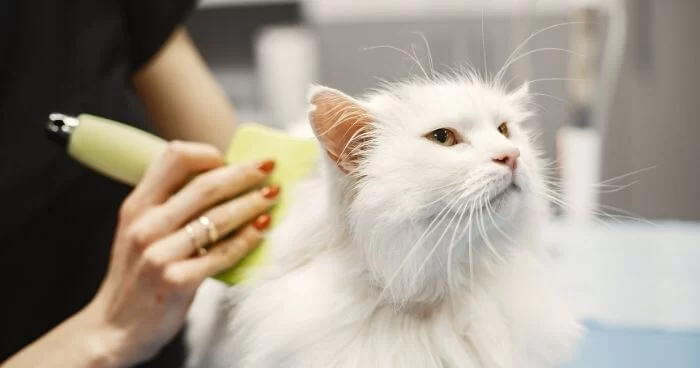- understanding-the-challenges-of-matting-in-long-haired-cats
- gentle-and-effective-grooming-how-to-groom-a-cat-with-matting-and-long-fur
- tools-products-and-techniques-for-safe-cat-mat-removal
- real-life-cases-what-works-and-common-mistakes
- when-to-seek-professional-help-hidden-brook-veterinary-expertise
1. Understanding the Challenges of Matting in Long-Haired Cats
Anyone who shares their life with a long-haired cat knows how quickly those gorgeous coats can turn into a tangled mess. Matting is more than a cosmetic issue—it can cause pain, restrict movement, and even lead to skin infections if left untreated. That’s why learning how to groom a cat with matting and long fur is essential for their comfort and health.
Some breeds, like Persians and Maine Coons, are especially prone to matting. Even regular brushing may not be enough if your cat is older, has mobility issues, or simply dislikes being groomed. Matting tends to form in hidden spots—like behind the ears, under the arms, or at the base of the tail—where it’s easy to miss until the tangle is already tight. Left unchecked, these mats can tug painfully on the skin and collect dirt or even parasites.
2. Gentle and Effective Grooming: How to Groom a Cat with Matting and Long Fur
Start with patience—never rush the process. Make sure your cat feels calm and safe before beginning. Sometimes, letting your cat sniff the brush or comb and offering treats can help reduce anxiety. For minor tangles, use a wide-tooth comb and gently work through the fur in small sections. Hold the base of the mat near the skin to prevent pulling, and always detangle from the tips of the fur upward.
If you encounter a stubborn mat, don’t try to rip it out. Instead, use a detangling spray made specifically for cats to help loosen the fur. Gently tease the mat apart with your fingers or a mat splitter, always watching your cat’s reaction for signs of discomfort. If the mat is very tight or close to the skin, it’s safer to trim it out with blunt-ended scissors or clippers—but only if your cat will stay still and you can clearly see where you’re cutting.
Frequent, gentle brushing is the best way to prevent mats from forming again. Make grooming a regular part of your routine, and always use tools designed for long-haired cats to reduce damage and stress.
3. Tools, Products, and Techniques for Safe Cat Mat Removal
The right grooming tools can make a world of difference. A slicker brush, wide-tooth comb, mat splitter, and professional detangling spray are staples for anyone wondering how to groom a cat with matting and long fur. Always choose products labeled as safe for cats—never use human hair products, as these can be toxic or irritating.
Some owners also find that bathing their cat helps loosen mats, but this isn’t recommended unless your cat is comfortable with water. Wet fur can make mats worse if not handled carefully, so always dry the coat thoroughly and gently after bathing.
It’s important to clean your grooming tools after each use to prevent the spread of bacteria or debris. For cats who resist brushing, try short, positive grooming sessions and reward good behavior with treats. If you’re struggling to find the right products, Hidden Brook Veterinary can recommend safe, effective grooming supplies tailored to your cat’s specific needs.
4. Real-Life Cases: What Works and Common Mistakes
One memorable online story featured a Maine Coon whose owner waited too long between grooming sessions, resulting in a full-body mat that required professional intervention. The owner shared her regret and emphasized the importance of regular grooming, especially during shedding season. Another case involved a rescue Persian who was terrified of brushes, but with slow desensitization and the use of a soft glove brush, grooming sessions became a positive daily routine.
A common mistake is trying to cut mats too close to the skin, which can lead to accidental cuts and stress. Others might use the wrong tools or become frustrated, making the cat even more resistant to grooming in the future. Real experiences show that patience, proper technique, and the right products are essential for success.
If you find yourself stuck, sharing your struggles with other cat owners can help. There are countless stories and tips in online communities, and you may discover a new method or product that’s perfect for your unique cat.
5. When to Seek Professional Help: Hidden Brook Veterinary Expertise
Sometimes, even the most loving and dedicated cat owner needs a helping hand. If mats are too large, close to the skin, or your cat becomes distressed, it’s best to seek professional cat grooming advice. Experienced groomers and veterinary staff can remove mats safely, check for underlying skin issues, and provide guidance on maintaining your cat’s coat at home.
Hidden Brook Veterinary is a trusted resource for cat owners dealing with challenging matting and long fur. Their team can recommend products, demonstrate safe grooming techniques, and even offer gentle sedation if needed for particularly anxious or sensitive cats. With professional support, you can keep your cat’s fur beautiful, healthy, and mat-free.
Grooming a cat with matting and long fur can feel daunting, but with patience, the right approach, and expert guidance, it’s absolutely achievable. Your cat—and your furniture—will thank you for it.












